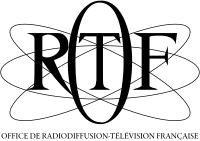Office de Radiodiffusion Télévision Française
The Office de Radiodiffusion-Télévision Française (ORTF) was the national agency charged, between 1964 and 1974, with providing public radio and television in France. All programming, and especially news broadcasts, were under strict control of the national government.[1][2]
 | |
| Type | Établissement public à caractère industriel et commercial |
|---|---|
| Country | France |
| Owner | Government of France |
Key people | Jacques-Bernard Dupont Jean-Jacques de Bresson Arthur Conte Marceau Long |
Launch date | June 27, 1964 |
| Dissolved | December 31, 1974 |
| Affiliates | Radio Stations:
TV Channels: Others:
|
| Replaced | Radiodiffusion-Télévision Française |
| Replaced by | TF1 France 2 France 3 SFP INA TDF Radio France |
Post World War II
A public monopoly on broadcasting in France had been established with the formation of Radiodiffusion Française (RDF) in 1945. RDF was renamed Radiodiffusion-Télévision Française (RTF) in 1949 and replaced by the ORTF in 1964.
In 1970, during a press conference, Georges Pompidou, initiated a will to modernize affirming that information to the ORTF must be free, independent and impartial, while stressing that it remains "the voice of France whether we like it or not. "[3]
From the beginning, the public broadcaster experienced fierce competition from the "peripheral stations": French-speaking stations aimed at the French public but transmitting on longwave from neighbouring countries, such as Radio Monte Carlo (RMC) from Monaco, Radio Luxembourg (later RTL) from Luxembourg, and Europe 1 from Germany (exceptionally, in 1974, RMC was allowed to set up a transmitter on French territory).
French broadcasting revolution
On December 31, 1974, the ORTF split in 5, leaving 7 successor institutions:
- Télévision Française 1 (TF1) (privatised in 1987)
- Antenne 2 (now France 2)
- France Régions 3 (now France 3)
- SFP - Société Française de Production (programme production)
- INA - Institut National de l'Audiovisuel (archives)
- TDF - Télédiffusion de France (transmission)
- Radio France - (Société Radio France) French national and international radio
Membership of the European Broadcasting Union
In 1950 the ORTF's predecessor, RTF, had been one of 23 founding broadcasting organisations of the European Broadcasting Union. Upon the break-up of the ORTF in 1974, French membership of the EBU was transferred to the transmission company TDF, while TF1 became a second French active member. A2, FR3, and SRF became supplementary active members before eventually becoming full members in 1982. In 1983 the French public broadcasters' membership was transferred to a joint organisation, the Organisme français de radiodiffusion et de télévision (OFRT). Nine years later, the OFRT was succeeded by the Groupement des Radiodiffuseurs Français de l’UER (GRF) which currently holds one of the French memberships of the EBU.
See also
- Radiodiffusion-Télévision Française
- Musique concrète
- Conseil Supérieur de l'Audiovisuel, regulating authorities
- Groupe TF1
- France Télévisions
- Orchestre National de France
References
- J.F.V. Keiger, France and the World since 1870 (2001) p 39.
- Raymond Kuhn (2006). The Media in France. Routledge. pp. 70–180. ISBN 9781134980536.
- "Naissance et disparition de l'ORTF". https://www.ina.fr/. Retrieved 17 February 2020. External link in
|website=(help)